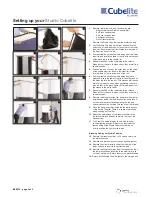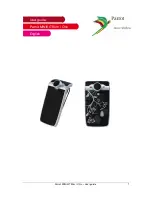
Back-Mount
Arm
TriSensor
ZWA005
Used in this guide.
Get help & learn more.
Should you encounter
any problem with TriSensor, visit
http://support.aeotec.com/trisensor or contact our support team via
aeotec.com/contact. You can also learn more about TriSensor
features, configuration options, and technical specifications at the
link.
Gateway compatibility.
To see if this device is known to be compatible with your Z-Wave gateway, please
refer to http://aeotec.com/z-wave-gateways
Declaration of Conformity.
Aeotec Limited declares that TriSensor is in compliance with the essential
requirements and other relevant provisions of RED 2014/53/EU, RoHS 2011/65/EU,
IEC62321:2008 and EN50581:2012. The full text of the declaration is available
from https://support.aeotec.com/trisensor/doc
Specifications.
ave devices operate between 868.40 & 926.3 MHz depending on local
restrictions. It uses up to -0.59dBm ERP of transmission power, enabling wireless
connectivity. Full information on device specifications and certifications at
support.aeotec.com/trisensor/specs
Association.
Thedevicesupports3associationgroups,andeachgroupsupportsmax5associatedno
des.
Group 1 is lifeline group; all nodes which associated in this group will receive the
messages sent by device throughlifeline.
Group 2 is controlling group, all nodes associated in this group will be controlled
through BASIC_SET command by the device when device detects a movement
2. Remove the backplate from TriSensor.
3. Remove the battery tab to engage the CR123A battery.
4. Replace the backplate.
5. Set your Z-Wave gateway into its ‘add device’ mode in order to
connect TriSensor to your Z-Wave system. Refer to the gateway’s
manual if you are unsure of how to perform this step.
6. Set TriSensor into its ‘add device’ mode;
a. If your Z-Wave gateway supports S2 encryption and DSK,
enter the first 5 digits of the DSK. Refer to ‘Used in this guide’
to locate the DSK if needed.
b. If your Z-Wave does not support DSK, press TriSensor’s
Action Button; its LED will turn yellow.
7. When TriSensor successfully joins your Z-Wave network, its LED will
turn alternate between white and green for 2 seconds. Should the
LED remain yellow and then flash green, TriSensor has been
unable to join your Z-Wave network; repeat the above steps and
please contact us for further support if needed.
8. TriSensor can be installed on a flat surface such as a shelf, in a
corner or on a wall using the Back-Mount Arm, or within a ceiling
or wall using its Recessor accessory (sold separately). If using
the Back-Mount Arm;
a. Screw Back-Mount Arm into the corresponding threaded hole
on the back of TriSensor.
b. Affix Back-Mount Arm to your desired location using the
provided double- sided tape or KA2.5×20 mm screws.
c. Angle TriSensor as desired.
event. Basic Set Value is decided by Configuration Parameter 6.
Group 3 is controlling group, all nodes associated in this group will be controlled
through BASIC_SET command by the device when device detects an ambient
temperature alarm (Decided by Configuration Parameter 7).
The Command Class supported by each association group is shown in the
tablebelow:
Command Class Configuration
The device supports the controller to configure parameters of the device through
Configuration Command Class, and the device has 21 parameters available for
users to set according to their different needs:
1) Motion Retrigger Time
This parameter is configured the delay time before PIR sensor can be
triggered again to reset motion timeout counter. Value = 0 will disable PIR
sensor from triggering until motion timeout has finished.
Important safety information.
Please read this and the electronic guide(s) at
http://support.aeotec.com/trisensor carefully. The failure to follow the
recommendations set forth by Aeotec Limited may be dangerous or
cause a violation of the law. The manufacturer, importer, distributor,
and / or reseller will not be held responsible for any loss or damage
resulting from not following any instructions in this guide or in other
materials.
TriSensor is intended for use in dry locations only. Do not use in
damp, moist, and / or wet locations.
Contains small parts; keep away from children.
Inclusion Description.
Press once TriSensor’s Action Button. If it is the first installation, the
yellow LED will keep solid until whole network processing is
complete. If successful, the LED will flash white -> green -> white ->
green, after 2 seconds finished. If failed, the yellow LED lasts for 30
seconds, then the green LED flashes once.
If it is the S2 encryption network, please enter the first 5 digits of
DSK.
Exclusion Description.
Press once TriSensor’s Action Button, the Purple LED will keep solid
until whole network processing is complete. If the exclusion is
successful, the LED will flash white -> green ->white -> green and
then LED will pulse a blue. If failed, the yellow LED lasts for 30
seconds, then the green LED flashes once.
Reset Description.
1. Power up the device.
2. Press and hold the button for 15s until Red Led is blinking,then
release the button.
Note:
Please use this procedure only when the network primary
controller is missing or otherwise inoperable.
Wakeup Description.
Press and hold the button at least 2s until Red Led is on and then
release the button,device will send wakeup notification to controller if
device is in a Z-Wave network.
Quick start.
The following will step you through installing TriSensor and
connecting it to your Z-Wave network.
1. Select an installation location for TriSensor. The sensor uses light
and heat readings to detect motion, so avoid pointing it at
sources of either. Tips on optimising the installation location of
TriSensor can be found online in its digital guide.
2) Motion Clear Time
This parameter is configured the time to clear motion event after a motion
event detected. Time to motion clear, the device will send a clear event report
3) Motion Sensitivity
This parameter is configured the sensitivity that motion detect. 0 – PIR sensor
disabled.
1 – Lowest
sensitivity. 11 – Highest
11 – Highest sensitivity.
4) Binary Sensor Report Enable
‘0’ – Disable sensor binary report when motion event is detected or cleared.
‘1’ – Enable sensor binary report when motion event is detected or cleared.
5) Disable BASIC_SET to Associated nodes
This parameter is configured the enabled or disabled send BASIC_SET
command to nodes that associated in group 2 and group 3.
0 – Disabled All Group Basic Set Command
1 – Enabled Group 2 Basic Set Command, Group 3 Basic Set Command is
disabled.
2 – Enabled Group 3 Basic Set Command, Group 2 Basic Set Command is
disabled.
3 – Enabled Group 2 and Group 3 Basic Set Command.
to controller and send BASIC_SET= 0x00 to nodes associated in group 2.
Unit: Second.
Screw (x2)
Parameter Number
1
2
30
0 ~ 32767
Size (Byte)
Available Settings
Default value
Group
1
(Lifeline)
COMMAND_CLASS_NOTIFICATION
COMMAND_CLASS_SENSOR_BINARY C
OMMAND_CLASS_SENSOR_MULTILEVEL
COMMAND_CLASS_BATTERY
COMMAND_CLASS_DEVICE_RESET_LOCALLY
COMMAND_CLASS_BASIC (HomeSecurity)
COMMAND_CLASS_BASIC(Temperature)
BASIC_SET
BASIC_SET
NOTIFICATION_REPORT
SENSOR_BINARY_REPORT
SENSOR_MULTILEVEL_REPORT
BATTERY_REPORT
DEVICE_RESET_LOCALLY_NOTIFICATION
2
(Control)
3
(Control)
CommandClass
Command
Parameter Number
2
2
240
1 ~ 32767
Size (Byte)
Available Settings
Default value
Parameter Number
3
1
11
0 ~ 11
Size (Byte)
Available Settings
Default value
Parameter Number
4
1
0
0 , 1
Size (Byte)
Available Settings
Default value
CR123A
Action Button
Battery slot
Threaded
hole
Lock
Backplate




















